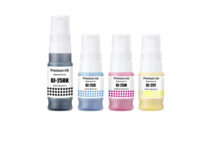While supplying an increasing number of overseas distributors, wholesalers, and other channel partners, Aster Graphics and Ninestar also poured time and treasure into assets that would allow them to grow their individual e-commerce businesses so they could sell directly to consumers and small businesses online. These e-commerce sales have led to conflicts between the Chinese third-party cartridge manufacturers and their channel partners, which often found themselves competing against their suppliers for the same customers online. Now, with online sales slumping, Aster Graphics and Ninestar seem to be trying to woo their B-to-B customers once again as they look for ways to buttress flagging revenue and profits.
By reducing—or eliminating—distributors and channel partners, Aster Graphics and Ninestar have reaped beefier margins for years through direct sales. Shortly after it began producing its new-build compatibles, Aster Graphics established itself on Amazon in 2012. Today, the firm maintains various subsidiaries supporting its online operations in Europe and the United States. Likewise, for over a decade Ninestar has done business online and it too operates subsidiaries dedicated to e-commerce in markets around the world. In addition to their own e-commerce operations, Aster Graphics and Ninestar leverage various services provided by Amazon to assist them to ship, warehouse, and fulfil orders to consumers across the European Union and North America.
Despite all the effort to grow their respective online businesses, recent financial reports and other data suggests that e-commerce sales are down at both Aster Graphics and Ninestar. As a result, each company is turning to its overseas distributors and other channel partners to grow—or at least maintain—sales volumes in Europe and North America. These overseas B-to-B customers, however, are aware of all the online activities at each of the Chinese firms. In fact, some must compete with their suppliers online at Amazon and other e-commerce sites. We wonder just how interested they will be to support Aster Graphics and Ninestar as they attempt to retain market share.
Longing to be Listed
In its failed bid to be listed on the Hong Kong Stock Exchange (HKSE), Aster Graphics changed its corporate name to Planet Image International, Ltd in 2020 (see “Aster Renews Application for Listing on Hong Kong Stock Exchange”). The company, which we continue to refer to as Aster Graphics, says it seeks to raise funds so it can more than double its production capacity from 27.7 million cartridges this year to 57.8 million in 2026. After being turned down by the Hong Kong bourse (see “No IPO for Now for Aster Graphics”), the company brought its road show to the United States last year, and has tried—thus far in vein—to be listed on the Nasdaq (see “Aster Files Initial Registration for Planet Image IPO on Nasdaq Stock Exchange” and “Planet Image Sets Terms for IPO”).
Aster Graphics’ most recent Form F-1/A, which was updated on September 28, offers valuable insight into the firm’s tripartite channel strategy. According to the filing, the firm sells to:
- Offline overseas customers marketing their brands on an Original Design Manufacturer (“ODM”) basis;
- Offline overseas dealers selling white-label products to end users as well as cartridges under various Aster Graphics brands; and
- Direct sales of Aster Graphics-branded products to customers through online retail platforms such as Amazon.
In its HKSE filings, Aster Graphics reported direct online sales had been its fastest growing source of revenue, accounting for 27.5 percent of total revenue in the first half of 2020. Last year, however, the firm’s online sales represented just 8.1 percent of its $142.1 million total worldwide revenue after slipping 55.0% from $25.7 million in 2021 to $11.4 million in 2022. Despite the sharp decline, the company says it expects sales to retail customers through the online stores operated by its subsidiaries to achieve the highest revenue increase and “serve as the driver for the operating subsidiaries’” future business growth.
Falling 7.6 percent to $58.0 million, Aster Graphics’ sales to ODM customers also declined last year. However, the firm’s dealers saved its bacon in 2022. Sales to dealers grew 36.8 percent to $72.6 million, representing 51.1 percent of Aster Graphics’ total sales. Thanks to its dealers, Aster Graphics managed to grow its total revenue by a meager 40 basis points.
While Aster Graphics’ dealer business is what allowed the firm to achieve its revenue growth last year albeit tiny, a quick look at the margins the firm’s online sales generated reveals why it’s committed to its direct sales. The gross profit margins from offline sales to dealers and to ODM customers were 46.4 percent and 23.6 percent, respectively, while the gross profit margin for its direct sales was a beefy 66.2 percent.
Ninestar’s Online Sales Down Too?
Although Ninestar Corporation’s financial reports, which are filed with the Shenzhen Stock Exchange, do not offer the level of detail that Aster Graphics provides in its Nasdaq filings, Ninestar has indicated that its third-party cartridge sales are down this year. According to the company’s financial report for the first 6 months of 2023 (see “Ninestar Delivers Lousy Financial Performance in H1 2023, It Will Get Worse in H2”), its consumables sales were off 6.2 percent compared to the same period last year, totaling CNY 2.9 billion or approximately $400.1 million.
While revenue from consumables sales were down modestly, profits plunged dramatically. Ninestar reported the net profit for its consumables business tumbled 42.8 percent year-over-year to CNY 79.0 million ($10.9 million) and contributed to Ninestar’s huge drop in net profit, which was off 76.4 percent. Given the healthy margins that direct sales deliver, it seems clear that the large drop in net profit came because of declining e-commerce sales, which impacted the top-line for Ninestar’s consumables business as well.
While not as conclusive as the reports we received from Ninestar itself, data gathered from third-party sources further signal that Ninestar’s online activity has been down this year. For example, import records collected by the global trade data service Datamyne track with Ninestar’s first-half financial report and show that that the firm’s shipments to the United States were down significantly in 2023 compared to last year. Moreover, market intelligence reports generated by the Viral Launch Amazon research tool similarly suggest that sales are down for various SKUs marketed under many of the cartridge brands Ninestar uses to sell on Amazon, such as INKNI, Lemero, myCartridge, and others.
We expect the rate of Ninestar’s declining online sales to accelerate during the second half of 2023. In June, the U.S. Department of Homeland Security (DHS) announced that Ninestar had been placed on the UFLPA Entity List after it was determined that the company employs forced labor to manufacture products at its factory in Zhuhai, China (see “Ninestar Imports Banned by U.S. Government Due to Forced Labor Concerns”). The move effectively bans the importation of Ninestar products into the United States. The company has sued the U.S. government challenging the legality of the listing. In filings made to support its suit, the company claims that its U.S. sales have all but dried up (see “Ninestar Reveals More in Motion for Injunction in Lawsuit against U.S. Government”). It appears that Ninestar’s G&G and Pantum branded products have been removed from Walmart.com (see “Walmart.com Drops Many Ninestar Cartridges and Pantum Products”), and we’ve heard unsubstantiated rumors that certain brick-and-mortar retailers are pulling products from Ninestar from their shelves.
How Will Channels React?
Over the next four to six quarters, we believe that Aster Graphics and Ninestar will need to rely increasingly on their channel partners to make up the declining revenue generated by their ailing online businesses. In its latest Nasdaq filing, Aster Graphics acknowledged as much, saying it aims to “attract and retain more local overseas wholesaler and dealer customers who operate online sales business” to grow sales. As noted, the company is also confident that its own online sales group will soon be back in its former position as the firm’s fastest growing business.
We wonder if either Aster Graphics or Ninestar can win over—or win back—channel partners that have lost market share to the pair on e-commerce platforms like Amazon. We recently conducted an informal poll of various companies that market third-party cartridges and most confirmed that they must compete for online sales with Aster Graphics and Ninestar, which are also frequently their suppliers. Most companies indicated that the two Chinese companies are formidable foes that have successfully gained market share at the expense of their customers.
Using services and other value-adds to enhance their value propositions, some of the firms we spoke with told us that they have developed strategies that allow them to vie for a share of the online market segments Aster Graphics and Ninestar have dominated for the past 10 years. It has cost these companies, however, both in terms of margin and assets. Others we spoke with said that they found it made more sense to cede certain market segments to Aster Graphics and Ninestar rather than lock horns with them in a pitched battle where the pair have critical advantages such as control of price and product availability.
Several firms we polled said they’ve experienced an uptick in business this year. This was especially true of companies that sell B-to-B to cartridge vendors in the United States. The groups that are currently gaining market share are cartridge manufacturers and remanufacturers that do not sell direct to end users, but instead sell exclusively to distributors, dealers, and wholesalers.
As we move through the second half of 2023 and into 2024, we expect to see changes in the competitive landscape. It seems unlikely, however, that either Aster Graphics or Ninestar will abandon their lucrative direct online sales operation. So, we’ll be watching to see if other manufacturers can win share from the pair by catering to the needs of their channel partners rather than selling direct.






